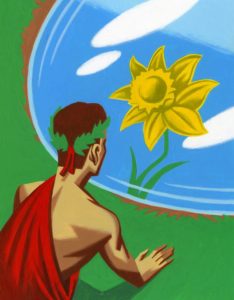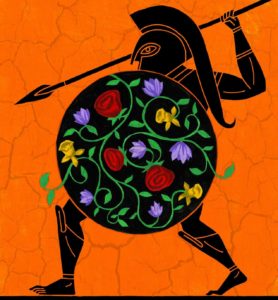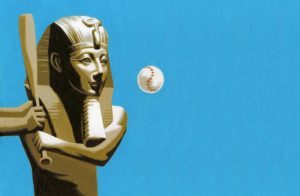The humble flower has been a favorite symbol in myth and art since ancient times
The Wall Street Journal, March 22, 2019

ILLUSTRATION: THOMAS FUCHS
On April 15, 1802, the poet William Wordsworth and his sister Dorothy were enjoying a spring walk through the hills and vales of the English Lake District when they came across a field of daffodils. Dorothy was so moved that she recorded the event in her journal, noting how the flowers “tossed and reeled and danced and seemed as if they verily laughed with the wind that blew upon them over the Lake.” And William decided there was nothing for it but to write a poem, which he published in its final version in 1815. “I Wandered Lonely as a Cloud” is one of his most famous reflections on the power of nature: “For oft, when on my couch I lie/In vacant or in pensive mood,/They flash upon that inward eye/Which is the bliss of solitude;/And then my heart with pleasure fills,/And dances with the daffodils.”
Long dismissed as a common field flower, unworthy of serious attention by the artist, poet or gardener, the daffodil enjoyed a revival thanks in part to Wordsworth’s poem. The painters Claude Monet, Berthe Morisot and Vincent van Gogh were among its 19th-century champions. Today, the daffodil is so ubiquitous, in gardens and in art, that it’s easy to overlook.
But the flower deserves respect for being a survivor. Every part of the narcissus, to use its scientific name, is toxic to humans, animals and even other flowers, and yet—as many cultures have noted—it seems immortal. There are still swaths of daffodils on the lakeside meadow where the Wordsworths ambled two centuries ago.
The daffodil originated in the ancient Mediterranean, where it was regarded with deep ambivalence. The ancient Egyptians associated narcissi with the idea of death and resurrection, using them in tomb paintings. The Greeks also gave the flower contrary mythological meanings. Its scientific name comes from the story of Narcissus, a handsome youth who faded away after being cursed into falling in love with his own image. At the last moment, the gods saved him from death by granting him a lifeless immortality as a daffodil. In another Greek myth, the daffodil’s luminous beauty was used by Hades to lure Persephone away from her friends so that he could abduct her into the underworld. During her four-month captivity the only flower she saw was the asphodelus, which grew in abundance on the fields of Elysium—and whose name inspired the English derivative “daffodil.”
But it is isn’t only Mediterranean cultures that have fixated on the daffodil’s mysterious alchemy of life and death. A fragrant variety of the narcissus—the sweet-smelling paper white—traveled along the Silk Road to China. There, too, the flower appeared to encapsulate the happy promise of spring, but also other painful emotions such as loss and yearning. The famous Ming Dynasty scroll painting “Narcissi and Plum Blossoms” by Qiu Ying (ca. 1494-1552), for instance, is a study in contrasts, juxtaposing exquisitely rendered flowers with the empty desolation of winter.
The English botanist John Parkinson introduced the traditional yellow variety from Spain in 1618. Aided by a soggy but temperate climate, daffodils quickly spread across lawns and fields, causing its foreign origins to be forgotten. By the 19th century they had become quintessentially British—so much so that missionaries and traders, nostalgic for home, planted bucketfuls of bulbs wherever they went. Their legacy in North America is a burst of color each year just when the browns and grays of winter have worn out their welcome.







